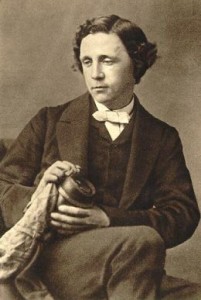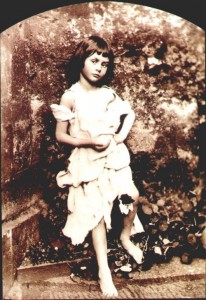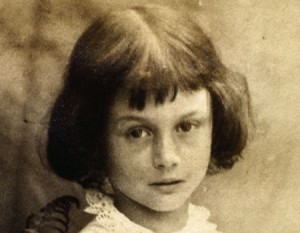 I was searching for info about an Alice in Wonderland in french, illustrated by an artist Morin, when another link popped up about a novel called Alice I Have Been by Melanie Benjamin published in 2010. I was surprised not to have known of it, and very excited to find it–I’d read slews of things about both Charles Dodgson, aka Lewis Carroll, and Alice Liddell, the girl for whom Carroll made up the story one day rowing on the Thames. I’d even been to Oxford, and Christ Church, the prestigious ancient place of learning that The Rev. Charles Dodgson taught math. I’d seen the little door leading out to a lovely garden and tree where Alice’s cat used to sit, the stained glass windows depicting the tea party, the portrait of Edith, one of Alice’s sisters who passed away in her early adulthood. Naturally, the idea of a novel written from the point of view of the child and adult Alice seemed to promise a fantastic treat. So, I read the book description, to get a feel for what wonderland the author offered. Right off the description gave me pause. “Part love story, part literary mystery” Love story? Certainly not between a child and 30 year old Dodgson, right? Reading the writer’s take on her own book, didn’t reassure me, it only made me more uncomfortable. She writes about the famous ‘beggar’ photo Dodgson took of Alice–the one in rags, looking disheveled and with facial expression up for interpretation. One interpretation I’d never had thought of, is this: “She was so adult, so frank, so worldly, as she gazed at the man behind the camera.” No. And no again. No child of 9 or 10 is adult and worldly. Especially during the restrictive Victorian age. Especially when Alice’s parents the dean and wife of Christ Church. Her next line sort of sealed my worst fears: “I wondered what happened between the two of them to result in such a startling photograph.”
I was searching for info about an Alice in Wonderland in french, illustrated by an artist Morin, when another link popped up about a novel called Alice I Have Been by Melanie Benjamin published in 2010. I was surprised not to have known of it, and very excited to find it–I’d read slews of things about both Charles Dodgson, aka Lewis Carroll, and Alice Liddell, the girl for whom Carroll made up the story one day rowing on the Thames. I’d even been to Oxford, and Christ Church, the prestigious ancient place of learning that The Rev. Charles Dodgson taught math. I’d seen the little door leading out to a lovely garden and tree where Alice’s cat used to sit, the stained glass windows depicting the tea party, the portrait of Edith, one of Alice’s sisters who passed away in her early adulthood. Naturally, the idea of a novel written from the point of view of the child and adult Alice seemed to promise a fantastic treat. So, I read the book description, to get a feel for what wonderland the author offered. Right off the description gave me pause. “Part love story, part literary mystery” Love story? Certainly not between a child and 30 year old Dodgson, right? Reading the writer’s take on her own book, didn’t reassure me, it only made me more uncomfortable. She writes about the famous ‘beggar’ photo Dodgson took of Alice–the one in rags, looking disheveled and with facial expression up for interpretation. One interpretation I’d never had thought of, is this: “She was so adult, so frank, so worldly, as she gazed at the man behind the camera.” No. And no again. No child of 9 or 10 is adult and worldly. Especially during the restrictive Victorian age. Especially when Alice’s parents the dean and wife of Christ Church. Her next line sort of sealed my worst fears: “I wondered what happened between the two of them to result in such a startling photograph.”
She wonders what happened between them?? We aren’t discussing a teenager–an age where some girls did marry, we aren’t even discussing a pre teen–we are talking about a child whose thoughts are on rabbits and tea parties and croquet matches, not about something happening between her and an adult. More disconcerting thoughts revealed: “What happened between the two of them 150 years ago continues to fascinate and inspire. It gave the world Wonderland, after all–” NOTHING happened between the two of them–is she not cognizant of where Alice and Dodgson where when he unraveled his tale for the first time? They weren’t alone. They were riding down the Isis, a part of the river Thames, with Alice and her sisters, another professor and Mrs. Liddell. Alice bugged Dodgson to write it down, but there was no particular intensity in it and by the time he did write it down, Alice was older and on to other things. The idea that some adult like relationship existed between them not only treats a little girl as a seducer, but it tarnishes the real Alice Liddell.
I’m not the typical Alice in Wonderland fanatic. I once belonged to the Lewis Carroll society, but found after awhile, that this kind of fanaticism wasn’t for me. First off, the academic aspect of his work interested me little. I’m don’t care that it was translated into Esperanto. Literary value is not the point of Alice, even though there are certainly incredible and significant aspects to the book that are timeless and that society has incorporated. But the book should be enjoyed for what Alice, her sisters, and Dodgson intended it to be–a fairy tale, a fun trip of opposites and riddles, and topsy turvy behavior that goes against Victorian society, and logic. All that said, I also cannot stomach the white washing of Dodgson’s behavior by those who will not separate the man from the art.
kind of fanaticism wasn’t for me. First off, the academic aspect of his work interested me little. I’m don’t care that it was translated into Esperanto. Literary value is not the point of Alice, even though there are certainly incredible and significant aspects to the book that are timeless and that society has incorporated. But the book should be enjoyed for what Alice, her sisters, and Dodgson intended it to be–a fairy tale, a fun trip of opposites and riddles, and topsy turvy behavior that goes against Victorian society, and logic. All that said, I also cannot stomach the white washing of Dodgson’s behavior by those who will not separate the man from the art.
Rev. Charles Dodgson had very few adult friends. It is well documented that the humans Dodgson spent 99 per cent of his time with were children. And, not all children, only one sex, little girls. Not teenage girls, but little girls–the kind that are adorable sweet things who wrote him letters and to which he responded, happily. Alice may have been a favorite, but she was far far from the only little girl he fixated upon. The man was 30–I repeat–30- when he came up with the story. There has been a backlash against those who hint that Dodgson was a pedophile. The idea that the hero who wrote this children’s classic could have in any way been inappropriate seems too much for some scholars who claim there is no evidence to support that. I agree, there is no real evidence to support actual physical pedophilia. But the arguments made that everyone took photos of nude children in that age, and it was considered art, and that his being friends with so many little girls was just an innocent thing due to his having all sisters is hogwash. Yes, there were others who took photos of children. So, because many took naked pictures of children during the Victorian era meant it was considered perfectly normal? Let’s get real. If those photos had been taken by a lower class person on the East side of London, and shown to others, they would not have been  considered ‘art.’ Art is art when the people who create it are in a powerful position. And even if other practitioners of nude photographs were strictly artists, that doesn’t automatically mean that Dodgson was also, that he had no other motive for this kind of voyeurism. Now scholars are claiming he had a healthy interest in adult women. I see. And that translated into dates, and being seen with them, and ? It was customary during the Victorian era to marry–there was nary a hint that Dodgson was remotely interested in such a thing. And then there’s allllll those letters from little girls, so many, so many responses, so few pieces of correspondence to adults. And of course there is the sudden break with the Liddell family over who knows what, and the pages of his diary having been ripped out, and several diaries from the pertinent time frame missing. Supposedly Mrs. Liddell burned Dodgson’s letters.
considered ‘art.’ Art is art when the people who create it are in a powerful position. And even if other practitioners of nude photographs were strictly artists, that doesn’t automatically mean that Dodgson was also, that he had no other motive for this kind of voyeurism. Now scholars are claiming he had a healthy interest in adult women. I see. And that translated into dates, and being seen with them, and ? It was customary during the Victorian era to marry–there was nary a hint that Dodgson was remotely interested in such a thing. And then there’s allllll those letters from little girls, so many, so many responses, so few pieces of correspondence to adults. And of course there is the sudden break with the Liddell family over who knows what, and the pages of his diary having been ripped out, and several diaries from the pertinent time frame missing. Supposedly Mrs. Liddell burned Dodgson’s letters.
Even, even if all the missing texts and letters are shown to be irrelevant–no one can get around the fact that he preferred little girls company to any others, he states this fact time and again.
So, if Carroll was a passive wishful thinking pedophile, or even just as an adult being with little girls too much of the time–that’s plain inappropriate–in Victorian time, and now. Because if someone had those habits today–he’d been hauled off to jail–or sued, like another child loving individual we know well named Michael Jackson, who was also pure as the driven snow.
None of these theories or scenarios ever cast aspersions on Alice as a willing participant in s0me shadowy relationship–at least not until this novel. I started reading reviews, which normally I ignore, because I wanted to get a better idea of whether or not I was being reactionary. One poster was brutal in her opinion:
“VERY DISTURBING NOVEL WHICH BLAMES PEDOPHILIA ON THE CHILD
I had to stop reading the book because the descriptions of interactions between Alice and Dodgson made my skin crawl. A truly creepy book which makes you wonder about the author.”
Another quotes from the novel:
“Romanticizes Disturbing Adult Relationship with a Child
For example, when Alice’s caregivers are distracted by the birth of a baby in the house, Mr. Dodgson takes seven-year-old Alice out, just the two of them, to photograph her in a secluded area on Oxford’s campus. He then asks her to change into a skimpy gypsy dress for one of the photographs. With all the buttons, clasps, and layers of the Victorian period, the child is unable to remove her own clothing. Mr. Dodgson appears and begins unhooking her buttons and lifting her clothes off of her. Even if a grown man undressing a seven-year-old girl in a hidden area didn’t raise a red flag, the way the author writes sensuality into the scene certainly does.
“…His hands upon my shoulders … They felt different; they felt – Bare. He had removed his gloves…”
“Here, let’s get you out of the rest …His hands trembled, and twisting around I saw as he unfastened my top petticoat…”
From Alice: “I tried to ignore whatever it was that was worrying me; it was too vague, at any rate, to name…”
During this same encounter, Mr. Dodgson tells Alice he dreams about her. Then her sister, Ina, discovers them and feels jealous of the special attention the older man pays her younger sister.
In another encounter with Mr. Dodgson when Alice is 10, there is even more adult interaction between the two.
“I bent my hand back, ever so slightly; our wrists touched. Flesh against flesh. He caught his breath in a ragged gasp.””
After having read these two, and a couple more who point these disturbing things out, I was not as thrilled to have found the  book. Naturally, there are more positive reviews than negative ones, but the positive ones don’t address these issues, they are ignored entirely, and they dwell on the magic of the story, or the sadness surrounding Alice at the end or some other typical flowery interpretation.
book. Naturally, there are more positive reviews than negative ones, but the positive ones don’t address these issues, they are ignored entirely, and they dwell on the magic of the story, or the sadness surrounding Alice at the end or some other typical flowery interpretation.
I really wanted to like this book, and to be fair, and I must try to be fair–I can’t completely judge until I read the entire book–but from the author’s own statements, and the quotes, the Alice she is writing about is not the flesh and blood one of history, unless she was a real life Lolita at age 10.
Where does it leave Carroll and Alice in Wonderland? Exactly where it was before. Charles Dodgson may have been an axe wielding maniac, or a pathetic socially shy man with no thoughts of little girls, or a peeping tom etc etc, make up a ‘truth’ here. In the end it doesn’t matter. Dodgson the man may have written the book, but the book is an entity unto itself, and needs to be recognized as such. The man and his work must be separated for readers to appreciate the story alone, without wondering if Alice’s fall down the rabbit hole was also a terrible fall from childhood and grace due to sick mind.

OK, those quotes creeped me out completely, I couldn’t read past the first two actually.
But I have learned something new, or maybe it’s something I’ve chosen to forget: that Dodgson corresponded with young girls to the exclusion of women. Nevertheless, this won’t detract from my enjoyment of the Alice stories… I’m sure I can separate the writer from the story.
Good for you, Nancy! So can I, and although I do think Dodgson was twisted to a degree, there is no substantial evidence that says he did anything physical. But, this author has Alice as a sexual being, at 7, and there is something so much more disturbing about that than thinking Dodgson may have abused girls. To blame the victim, or blame the girl who is being photographed in this fashion is insidiously planting the idea of sexualized children back into the current dialog–and romanticizing a particularly horrible betrayal of the innocence that should be our children’s right.